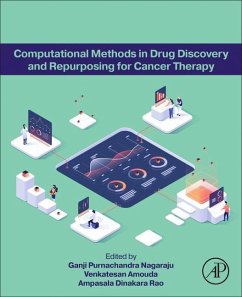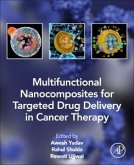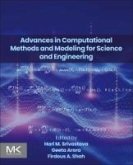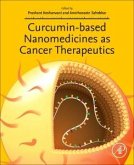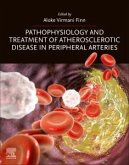Computational Methods in Drug Discovery and Repurposing for Cancer Therapy
Herausgeber: Nagaraju, Ganji Purnachandra; Dinakara Rao, Ampasala; Amouda, Venkatesan
Computational Methods in Drug Discovery and Repurposing for Cancer Therapy
Herausgeber: Nagaraju, Ganji Purnachandra; Dinakara Rao, Ampasala; Amouda, Venkatesan
- Broschiertes Buch
- Merkliste
- Auf die Merkliste
- Bewerten Bewerten
- Teilen
- Produkt teilen
- Produkterinnerung
- Produkterinnerung
Computational Methods in Drug Discovery and Repurposing for Cancer Therapy provides knowledge about ongoing research as well as computational approaches for drug discovery and repurposing for cancer therapy. The book also provides detailed descriptions about target molecules, pathways, and their inhibitors for easy understanding and applicability. The book discusses tools and techniques such as integrated bioinformatics approaches, systems biology tools, molecular docking, computational chemistry, artificial intelligence, machine learning, structure-based virtual screening, biomarkers, and…mehr
Andere Kunden interessierten sich auch für
![Multifunctional Nanocomposites for Targeted Drug Delivery in Cancer Therapy Multifunctional Nanocomposites for Targeted Drug Delivery in Cancer Therapy]() Awesh K YadavMultifunctional Nanocomposites for Targeted Drug Delivery in Cancer Therapy172,99 €
Awesh K YadavMultifunctional Nanocomposites for Targeted Drug Delivery in Cancer Therapy172,99 €![Caspases as Molecular Targets for Cancer Therapy Caspases as Molecular Targets for Cancer Therapy]() Caspases as Molecular Targets for Cancer Therapy172,99 €
Caspases as Molecular Targets for Cancer Therapy172,99 €![Advances in Computational Methods and Modeling for Science and Engineering Advances in Computational Methods and Modeling for Science and Engineering]() Advances in Computational Methods and Modeling for Science and Engineering188,99 €
Advances in Computational Methods and Modeling for Science and Engineering188,99 €![Curcumin-Based Nanomedicines as Cancer Therapeutics Curcumin-Based Nanomedicines as Cancer Therapeutics]() Curcumin-Based Nanomedicines as Cancer Therapeutics172,99 €
Curcumin-Based Nanomedicines as Cancer Therapeutics172,99 €![Therapeutic Applications of Nitric Oxide in Cancer and Inflammatory Disorders Therapeutic Applications of Nitric Oxide in Cancer and Inflammatory Disorders]() Therapeutic Applications of Nitric Oxide in Cancer and Inflammatory Disorders184,99 €
Therapeutic Applications of Nitric Oxide in Cancer and Inflammatory Disorders184,99 €![Advances in Cancer Biomarkers Research Advances in Cancer Biomarkers Research]() Advances in Cancer Biomarkers Research172,99 €
Advances in Cancer Biomarkers Research172,99 €![Pathophysiology and Treatment of Atherosclerotic Disease in Peripheral Arteries Pathophysiology and Treatment of Atherosclerotic Disease in Peripheral Arteries]() Pathophysiology and Treatment of Atherosclerotic Disease in Peripheral Arteries172,99 €
Pathophysiology and Treatment of Atherosclerotic Disease in Peripheral Arteries172,99 €-
-
-
Computational Methods in Drug Discovery and Repurposing for Cancer Therapy provides knowledge about ongoing research as well as computational approaches for drug discovery and repurposing for cancer therapy. The book also provides detailed descriptions about target molecules, pathways, and their inhibitors for easy understanding and applicability. The book discusses tools and techniques such as integrated bioinformatics approaches, systems biology tools, molecular docking, computational chemistry, artificial intelligence, machine learning, structure-based virtual screening, biomarkers, and transcriptome; those are discussed in the context of different cancer types, such as colon, pancreatic, glioblastoma, endometrial, and retinoblastoma, among others. This book is a valuable resource for researchers, students, and members of the biomedical and medical fields who want to learn more about the use of computational modeling to better tailor the treatment for cancer patients.
Hinweis: Dieser Artikel kann nur an eine deutsche Lieferadresse ausgeliefert werden.
Hinweis: Dieser Artikel kann nur an eine deutsche Lieferadresse ausgeliefert werden.
Produktdetails
- Produktdetails
- Verlag: Elsevier Science
- Seitenzahl: 456
- Erscheinungstermin: 22. März 2023
- Englisch
- Abmessung: 191mm x 234mm x 26mm
- Gewicht: 450g
- ISBN-13: 9780443152801
- ISBN-10: 0443152802
- Artikelnr.: 66174045
- Herstellerkennzeichnung
- Libri GmbH
- Europaallee 1
- 36244 Bad Hersfeld
- gpsr@libri.de
- Verlag: Elsevier Science
- Seitenzahl: 456
- Erscheinungstermin: 22. März 2023
- Englisch
- Abmessung: 191mm x 234mm x 26mm
- Gewicht: 450g
- ISBN-13: 9780443152801
- ISBN-10: 0443152802
- Artikelnr.: 66174045
- Herstellerkennzeichnung
- Libri GmbH
- Europaallee 1
- 36244 Bad Hersfeld
- gpsr@libri.de
Contributors About the editors Preface
1. Computational approaches for anticancer drug design Tha Luong, Grace
Persis Burri, Yuvasri Golivi, Ganji Purnachandra Nagaraju, and Bassel F.
El-Rayes
1. Introduction 2. Current computational approaches for cancer drug designs
3. Applications of computational approaches in cancer drug designing 4.
Challenges and future directions 5. Conclusion References
2. Molecular modeling approach in cancer drug therapy Bhavini Singh,
Rishabh Rege, and Ganji Purnachandra Nagaraju
1. Introduction 2. Drug designing 3. Molecular modeling 4. Methods of
molecular modeling 5. Applications of molecular modeling 6. Applications in
multidrug-resistant proteins 7. Conclusion References
3. Discovery of anticancer therapeutics: Computational chemistry and
Artificial Intelligence-assisted approach Subrata Das, Anupam Das Talukdar,
Deepa Nath, and Manabendra Dutta Choudhury
1. Introduction 2. Drug repurposing 3. Computational chemistry in drug
designing 4. Structure-based drug designing 5. ADME/Tox screening and
drug-likeness prediction 6. Molecular docking 7. Quantitative
structure-activity relationship modeling 8. Molecular dynamics simulation
9. Artificial Intelligence in drug discovery 10. Conclusion References
4. Artificial intelligence in oncological therapies Shloka Adluru
1. Introduction 2. Importance of early diagnosis 3. How AI can improve
accuracy and speed of cancer diagnoses 4. How AI can assess patient
background information to determine risk of cancer 5. Diagnosis of cancer
subtype and stage 6. AI in cancer drug discovery and development 7. De novo
drug design 8. AI in recommending drug combinations and repurposing drugs
9. AI in identifying drug-target interactions 10. Deep learning, black
boxes, and hidden layers 11. Future of AI in oncology 12. Conclusion
References
5. Approach of artificial intelligence in colorectal cancer and in
precision medicine Grace Persis Burri, Yuvasri Golivi, Tha Luong, Neha
Merchant, and Ganji Purnachandra Nagaraju
1. Introduction2. Applications of AI in CRC3. Robotic-assisted surgery 4.
Precision medicine in CRC 5. Benefits 6. Limitations 7. Current challenges
and prospects 8. Conclusion Conflict of interest Funding References
6. Artificial intelligence in breast cancer: An opportunity for early
diagnosis Rama Rao Malla and Vedavathi Katneni
1. Machine learning 2. Breast cancer 3. Conclusion References
7. Quantitative structure-activity relationship and its application to
cancer therapy Bhavini Singh and Rishabh Rege
1. Introduction 2. Function 3. Origin of QSAR 4. Advanced techniques of
QSAR 5. Application in drug design 6. Application in cancer therapy 7.
Concerns 8. Conclusion References
8. Structure-based virtual screening strategy for the identification of
novel Greatwall kinase inhibitors Anbumani VelmuruganIlavarasi, Tulsi,
Saswati Sarita Mohanty, Katike Umamahesh, Amouda Venkatesan, and Dinakara
Rao Ampasala
1. Introduction 2. Computational methods 3. Results and discussion 4.
Conclusion Acknowledgments Conflict of interest References
9. Strategies for drug repurposing Aparna Vema and Arunasree M. Kalle
1. Introduction 2. Computational drug repurposing 3. Experimental drug
repurposing 4. Conclusions and perspectives Author contributions Financial
disclosures Conflict of interest References
10. Principles of computational drug designing and drug repurposing-An
algorithmic approach Angshuman Bagchi
1. Introduction 2. Overview of basic thermodynamic principles involved in
computational algorithms 3. Fundamentals of computational algorithms 4.
Searching the conformational space 5. Analysis of protein flexibility 6.
Drug repurposing 7. Conclusion Acknowledgment References
11. Drug discovery and repositioning for glioblastoma multiforme and
low-grade astrocytic tumors Asmita Dasgupta, Sanjukta Ghosh, Kastro
Kalidass, and Shabnam Farisha
1. Introduction 2. Approved therapeutics for astrocytic tumors 3. Drug
discovery approaches against astrocytic tumors 4. Drug discovery for
astrocytic tumors by virtual screening 5. Drug repositioning in astrocytic
tumor therapy 6. Conclusion Acknowledgments Conflict of interest References
12. Repurposing of phytocompounds-derived novel bioactive compounds
possessing promising anticancer and cancer therapeutic efficacy through
molecular docking, MD simulation, and drug-likeness/ADMET
studiesRajalakshmi Manikkam, Vijayalakshmi Periyasamy, and Indu Sabapathy
1. Drug repurposing 2. Strategies in drug repurposing 3. Pros and cons of
drug repurposing 4. Computational advancements in oncology research 5.
Structure-based and target-based virtual screening 6. Systems biology
integrated approach in drug repositioning 7. In silico databases and
web-based tools for drug repurposing 8. Phytochemicals repurposed in cancer
therapy 9. Antidiabetic phytocompounds repurposed for cancer therapy 10.
Conclusion References
13. Old drugs and new opportunities-Drug repurposing in colon cancer
prevention Vemula Sarojamma, Manoj Kumar Gupta, Jeelan Basha Shaik, and
Ramakrishna Vadde
1. Introduction 2. Principles and tools used in drug repurposing 3.
Categories of repurposed drugs against human cancers 4. Drugs used in the
treatment of colon cancer 5. Drug repurposing in the prevention of colon
cancer 6. Drug repurposing pitfalls 7. Computational approaches in drug
repurposing for colorectal cancer 8. Conclusions and perspectives Conflicts
of interest References
14. Repurposing cardiac glycosides as potent immune system modulators in
cancer therapy Honey Pavithran, Angelina K. Job, and Ranjith Kumavath
1. Introduction 2. Repurposing cardiac glycosides in cancer treatment 3.
CGs hamper Na+/K+-ATPase signaling complex in cancer 4. Role of the immune
system in cancer 5. Conclusions Acknowledgments Consent for publication
Ethics approval and consent to participate Conflict of interest References
15. Systems biology tools for the identification of potential drug targets
and biological markers effective for cancer therapeutics Gayathri Ashok, P.
Priyamvada, Sravan Kumar Miryala, Anand Anbarasu, and Sudha Ramaiah
1. Introduction 2. Current problems in cancer therapies 3. Need for
alternative approaches in cancer 4. GIN: A systems biology approach 5.
Types of biological networks 6. Cancer databases 7. Databases for
interaction data curation 8. Network construction and visualization 9.
Network analysis 10. How can the identified targets be used for cancer
therapy? 11. Conclusion Acknowledgments Conflict of interest Authors'
contribution References
16. Role of human body fluid biomarkers in liver cancer: A systematic
review Dahrii Paul, Vigneshwar Suriya Prakash Sinnarasan, Rajesh Das,
Dinakara Rao Ampasala, and Amouda Venkatesan
1. Introduction 2. Methods 3. Results 4. Discussion 5. Conclusions
References
17. Study on biomarkers in endometrial cancer using transcriptome data: A
machine learning approach Dahrii Paul, Vigneshwar Suriya Prakash
Sinnarasan, Rajesh Das, Dinakara Rao Ampasala, and Amouda Venkatesan
1. Introduction 2. Materials and methods 3. Results 4. Discussion 5.
Conclusion References
18. Multifaceted functions of PIWI/piRNA complex in cancer and as a
therapeutic target for retinoblastoma Rupa Roy, Muthuramalingam
Karpagavalli, Athira Ramesh, Jayamuruga Pandian Arunachalam, Sudha Rani
Sadras, and Subbulakshmi Chidambaram
1. Introduction 2. Biological functions of PIWI/piRNA in physiological
conditions 3. Emerging significance of PIWI/piRNA in various cancers 4.
Retina and its structure 5. Potential role of PIWI and piRNA in RB 6.
PIWI/piRNA as future biomarkers in cancer 7. Conclusion Acknowledgments
Declaration of competing interest References
19. Emerging role of biosimilars: Focus on Bevacizumab and hepatocellular
carcinoma Anum Jalil, James Wert, Akriti Gupta Jain, and Sarfraz Ahmad
1. Introduction 2. Biologics and biosimilars 3. FDA approved biosimilars to
date 4. Role of Bevacizumab and its biosimilar in hepatocellular carcinoma
5. Clinical trials with Bevacizumab and its biosimilar in HCC 6.
Conclusions and future perspectives Funding Authors' contribution
References
20. Integrated computational approaches to aid precision medicine for
cancer therapy: Present scenario and future prospects Hithesh Kumar, Sravan
Kumar Miryala, Anand Anbarasu, and Sudha Ramaiah
1. Introduction 2. Precision cancer medicine: Prospects and hurdles 3. Next
generation sequencing and computational genomics in PCM 4. Drug
repositioning using translational bioinformatics 5. Future perspectives 6.
Conclusion Acknowledgment Author contributions Declaration of interests
References Index
1. Computational approaches for anticancer drug design Tha Luong, Grace
Persis Burri, Yuvasri Golivi, Ganji Purnachandra Nagaraju, and Bassel F.
El-Rayes
1. Introduction 2. Current computational approaches for cancer drug designs
3. Applications of computational approaches in cancer drug designing 4.
Challenges and future directions 5. Conclusion References
2. Molecular modeling approach in cancer drug therapy Bhavini Singh,
Rishabh Rege, and Ganji Purnachandra Nagaraju
1. Introduction 2. Drug designing 3. Molecular modeling 4. Methods of
molecular modeling 5. Applications of molecular modeling 6. Applications in
multidrug-resistant proteins 7. Conclusion References
3. Discovery of anticancer therapeutics: Computational chemistry and
Artificial Intelligence-assisted approach Subrata Das, Anupam Das Talukdar,
Deepa Nath, and Manabendra Dutta Choudhury
1. Introduction 2. Drug repurposing 3. Computational chemistry in drug
designing 4. Structure-based drug designing 5. ADME/Tox screening and
drug-likeness prediction 6. Molecular docking 7. Quantitative
structure-activity relationship modeling 8. Molecular dynamics simulation
9. Artificial Intelligence in drug discovery 10. Conclusion References
4. Artificial intelligence in oncological therapies Shloka Adluru
1. Introduction 2. Importance of early diagnosis 3. How AI can improve
accuracy and speed of cancer diagnoses 4. How AI can assess patient
background information to determine risk of cancer 5. Diagnosis of cancer
subtype and stage 6. AI in cancer drug discovery and development 7. De novo
drug design 8. AI in recommending drug combinations and repurposing drugs
9. AI in identifying drug-target interactions 10. Deep learning, black
boxes, and hidden layers 11. Future of AI in oncology 12. Conclusion
References
5. Approach of artificial intelligence in colorectal cancer and in
precision medicine Grace Persis Burri, Yuvasri Golivi, Tha Luong, Neha
Merchant, and Ganji Purnachandra Nagaraju
1. Introduction2. Applications of AI in CRC3. Robotic-assisted surgery 4.
Precision medicine in CRC 5. Benefits 6. Limitations 7. Current challenges
and prospects 8. Conclusion Conflict of interest Funding References
6. Artificial intelligence in breast cancer: An opportunity for early
diagnosis Rama Rao Malla and Vedavathi Katneni
1. Machine learning 2. Breast cancer 3. Conclusion References
7. Quantitative structure-activity relationship and its application to
cancer therapy Bhavini Singh and Rishabh Rege
1. Introduction 2. Function 3. Origin of QSAR 4. Advanced techniques of
QSAR 5. Application in drug design 6. Application in cancer therapy 7.
Concerns 8. Conclusion References
8. Structure-based virtual screening strategy for the identification of
novel Greatwall kinase inhibitors Anbumani VelmuruganIlavarasi, Tulsi,
Saswati Sarita Mohanty, Katike Umamahesh, Amouda Venkatesan, and Dinakara
Rao Ampasala
1. Introduction 2. Computational methods 3. Results and discussion 4.
Conclusion Acknowledgments Conflict of interest References
9. Strategies for drug repurposing Aparna Vema and Arunasree M. Kalle
1. Introduction 2. Computational drug repurposing 3. Experimental drug
repurposing 4. Conclusions and perspectives Author contributions Financial
disclosures Conflict of interest References
10. Principles of computational drug designing and drug repurposing-An
algorithmic approach Angshuman Bagchi
1. Introduction 2. Overview of basic thermodynamic principles involved in
computational algorithms 3. Fundamentals of computational algorithms 4.
Searching the conformational space 5. Analysis of protein flexibility 6.
Drug repurposing 7. Conclusion Acknowledgment References
11. Drug discovery and repositioning for glioblastoma multiforme and
low-grade astrocytic tumors Asmita Dasgupta, Sanjukta Ghosh, Kastro
Kalidass, and Shabnam Farisha
1. Introduction 2. Approved therapeutics for astrocytic tumors 3. Drug
discovery approaches against astrocytic tumors 4. Drug discovery for
astrocytic tumors by virtual screening 5. Drug repositioning in astrocytic
tumor therapy 6. Conclusion Acknowledgments Conflict of interest References
12. Repurposing of phytocompounds-derived novel bioactive compounds
possessing promising anticancer and cancer therapeutic efficacy through
molecular docking, MD simulation, and drug-likeness/ADMET
studiesRajalakshmi Manikkam, Vijayalakshmi Periyasamy, and Indu Sabapathy
1. Drug repurposing 2. Strategies in drug repurposing 3. Pros and cons of
drug repurposing 4. Computational advancements in oncology research 5.
Structure-based and target-based virtual screening 6. Systems biology
integrated approach in drug repositioning 7. In silico databases and
web-based tools for drug repurposing 8. Phytochemicals repurposed in cancer
therapy 9. Antidiabetic phytocompounds repurposed for cancer therapy 10.
Conclusion References
13. Old drugs and new opportunities-Drug repurposing in colon cancer
prevention Vemula Sarojamma, Manoj Kumar Gupta, Jeelan Basha Shaik, and
Ramakrishna Vadde
1. Introduction 2. Principles and tools used in drug repurposing 3.
Categories of repurposed drugs against human cancers 4. Drugs used in the
treatment of colon cancer 5. Drug repurposing in the prevention of colon
cancer 6. Drug repurposing pitfalls 7. Computational approaches in drug
repurposing for colorectal cancer 8. Conclusions and perspectives Conflicts
of interest References
14. Repurposing cardiac glycosides as potent immune system modulators in
cancer therapy Honey Pavithran, Angelina K. Job, and Ranjith Kumavath
1. Introduction 2. Repurposing cardiac glycosides in cancer treatment 3.
CGs hamper Na+/K+-ATPase signaling complex in cancer 4. Role of the immune
system in cancer 5. Conclusions Acknowledgments Consent for publication
Ethics approval and consent to participate Conflict of interest References
15. Systems biology tools for the identification of potential drug targets
and biological markers effective for cancer therapeutics Gayathri Ashok, P.
Priyamvada, Sravan Kumar Miryala, Anand Anbarasu, and Sudha Ramaiah
1. Introduction 2. Current problems in cancer therapies 3. Need for
alternative approaches in cancer 4. GIN: A systems biology approach 5.
Types of biological networks 6. Cancer databases 7. Databases for
interaction data curation 8. Network construction and visualization 9.
Network analysis 10. How can the identified targets be used for cancer
therapy? 11. Conclusion Acknowledgments Conflict of interest Authors'
contribution References
16. Role of human body fluid biomarkers in liver cancer: A systematic
review Dahrii Paul, Vigneshwar Suriya Prakash Sinnarasan, Rajesh Das,
Dinakara Rao Ampasala, and Amouda Venkatesan
1. Introduction 2. Methods 3. Results 4. Discussion 5. Conclusions
References
17. Study on biomarkers in endometrial cancer using transcriptome data: A
machine learning approach Dahrii Paul, Vigneshwar Suriya Prakash
Sinnarasan, Rajesh Das, Dinakara Rao Ampasala, and Amouda Venkatesan
1. Introduction 2. Materials and methods 3. Results 4. Discussion 5.
Conclusion References
18. Multifaceted functions of PIWI/piRNA complex in cancer and as a
therapeutic target for retinoblastoma Rupa Roy, Muthuramalingam
Karpagavalli, Athira Ramesh, Jayamuruga Pandian Arunachalam, Sudha Rani
Sadras, and Subbulakshmi Chidambaram
1. Introduction 2. Biological functions of PIWI/piRNA in physiological
conditions 3. Emerging significance of PIWI/piRNA in various cancers 4.
Retina and its structure 5. Potential role of PIWI and piRNA in RB 6.
PIWI/piRNA as future biomarkers in cancer 7. Conclusion Acknowledgments
Declaration of competing interest References
19. Emerging role of biosimilars: Focus on Bevacizumab and hepatocellular
carcinoma Anum Jalil, James Wert, Akriti Gupta Jain, and Sarfraz Ahmad
1. Introduction 2. Biologics and biosimilars 3. FDA approved biosimilars to
date 4. Role of Bevacizumab and its biosimilar in hepatocellular carcinoma
5. Clinical trials with Bevacizumab and its biosimilar in HCC 6.
Conclusions and future perspectives Funding Authors' contribution
References
20. Integrated computational approaches to aid precision medicine for
cancer therapy: Present scenario and future prospects Hithesh Kumar, Sravan
Kumar Miryala, Anand Anbarasu, and Sudha Ramaiah
1. Introduction 2. Precision cancer medicine: Prospects and hurdles 3. Next
generation sequencing and computational genomics in PCM 4. Drug
repositioning using translational bioinformatics 5. Future perspectives 6.
Conclusion Acknowledgment Author contributions Declaration of interests
References Index
Contributors About the editors Preface
1. Computational approaches for anticancer drug design Tha Luong, Grace
Persis Burri, Yuvasri Golivi, Ganji Purnachandra Nagaraju, and Bassel F.
El-Rayes
1. Introduction 2. Current computational approaches for cancer drug designs
3. Applications of computational approaches in cancer drug designing 4.
Challenges and future directions 5. Conclusion References
2. Molecular modeling approach in cancer drug therapy Bhavini Singh,
Rishabh Rege, and Ganji Purnachandra Nagaraju
1. Introduction 2. Drug designing 3. Molecular modeling 4. Methods of
molecular modeling 5. Applications of molecular modeling 6. Applications in
multidrug-resistant proteins 7. Conclusion References
3. Discovery of anticancer therapeutics: Computational chemistry and
Artificial Intelligence-assisted approach Subrata Das, Anupam Das Talukdar,
Deepa Nath, and Manabendra Dutta Choudhury
1. Introduction 2. Drug repurposing 3. Computational chemistry in drug
designing 4. Structure-based drug designing 5. ADME/Tox screening and
drug-likeness prediction 6. Molecular docking 7. Quantitative
structure-activity relationship modeling 8. Molecular dynamics simulation
9. Artificial Intelligence in drug discovery 10. Conclusion References
4. Artificial intelligence in oncological therapies Shloka Adluru
1. Introduction 2. Importance of early diagnosis 3. How AI can improve
accuracy and speed of cancer diagnoses 4. How AI can assess patient
background information to determine risk of cancer 5. Diagnosis of cancer
subtype and stage 6. AI in cancer drug discovery and development 7. De novo
drug design 8. AI in recommending drug combinations and repurposing drugs
9. AI in identifying drug-target interactions 10. Deep learning, black
boxes, and hidden layers 11. Future of AI in oncology 12. Conclusion
References
5. Approach of artificial intelligence in colorectal cancer and in
precision medicine Grace Persis Burri, Yuvasri Golivi, Tha Luong, Neha
Merchant, and Ganji Purnachandra Nagaraju
1. Introduction2. Applications of AI in CRC3. Robotic-assisted surgery 4.
Precision medicine in CRC 5. Benefits 6. Limitations 7. Current challenges
and prospects 8. Conclusion Conflict of interest Funding References
6. Artificial intelligence in breast cancer: An opportunity for early
diagnosis Rama Rao Malla and Vedavathi Katneni
1. Machine learning 2. Breast cancer 3. Conclusion References
7. Quantitative structure-activity relationship and its application to
cancer therapy Bhavini Singh and Rishabh Rege
1. Introduction 2. Function 3. Origin of QSAR 4. Advanced techniques of
QSAR 5. Application in drug design 6. Application in cancer therapy 7.
Concerns 8. Conclusion References
8. Structure-based virtual screening strategy for the identification of
novel Greatwall kinase inhibitors Anbumani VelmuruganIlavarasi, Tulsi,
Saswati Sarita Mohanty, Katike Umamahesh, Amouda Venkatesan, and Dinakara
Rao Ampasala
1. Introduction 2. Computational methods 3. Results and discussion 4.
Conclusion Acknowledgments Conflict of interest References
9. Strategies for drug repurposing Aparna Vema and Arunasree M. Kalle
1. Introduction 2. Computational drug repurposing 3. Experimental drug
repurposing 4. Conclusions and perspectives Author contributions Financial
disclosures Conflict of interest References
10. Principles of computational drug designing and drug repurposing-An
algorithmic approach Angshuman Bagchi
1. Introduction 2. Overview of basic thermodynamic principles involved in
computational algorithms 3. Fundamentals of computational algorithms 4.
Searching the conformational space 5. Analysis of protein flexibility 6.
Drug repurposing 7. Conclusion Acknowledgment References
11. Drug discovery and repositioning for glioblastoma multiforme and
low-grade astrocytic tumors Asmita Dasgupta, Sanjukta Ghosh, Kastro
Kalidass, and Shabnam Farisha
1. Introduction 2. Approved therapeutics for astrocytic tumors 3. Drug
discovery approaches against astrocytic tumors 4. Drug discovery for
astrocytic tumors by virtual screening 5. Drug repositioning in astrocytic
tumor therapy 6. Conclusion Acknowledgments Conflict of interest References
12. Repurposing of phytocompounds-derived novel bioactive compounds
possessing promising anticancer and cancer therapeutic efficacy through
molecular docking, MD simulation, and drug-likeness/ADMET
studiesRajalakshmi Manikkam, Vijayalakshmi Periyasamy, and Indu Sabapathy
1. Drug repurposing 2. Strategies in drug repurposing 3. Pros and cons of
drug repurposing 4. Computational advancements in oncology research 5.
Structure-based and target-based virtual screening 6. Systems biology
integrated approach in drug repositioning 7. In silico databases and
web-based tools for drug repurposing 8. Phytochemicals repurposed in cancer
therapy 9. Antidiabetic phytocompounds repurposed for cancer therapy 10.
Conclusion References
13. Old drugs and new opportunities-Drug repurposing in colon cancer
prevention Vemula Sarojamma, Manoj Kumar Gupta, Jeelan Basha Shaik, and
Ramakrishna Vadde
1. Introduction 2. Principles and tools used in drug repurposing 3.
Categories of repurposed drugs against human cancers 4. Drugs used in the
treatment of colon cancer 5. Drug repurposing in the prevention of colon
cancer 6. Drug repurposing pitfalls 7. Computational approaches in drug
repurposing for colorectal cancer 8. Conclusions and perspectives Conflicts
of interest References
14. Repurposing cardiac glycosides as potent immune system modulators in
cancer therapy Honey Pavithran, Angelina K. Job, and Ranjith Kumavath
1. Introduction 2. Repurposing cardiac glycosides in cancer treatment 3.
CGs hamper Na+/K+-ATPase signaling complex in cancer 4. Role of the immune
system in cancer 5. Conclusions Acknowledgments Consent for publication
Ethics approval and consent to participate Conflict of interest References
15. Systems biology tools for the identification of potential drug targets
and biological markers effective for cancer therapeutics Gayathri Ashok, P.
Priyamvada, Sravan Kumar Miryala, Anand Anbarasu, and Sudha Ramaiah
1. Introduction 2. Current problems in cancer therapies 3. Need for
alternative approaches in cancer 4. GIN: A systems biology approach 5.
Types of biological networks 6. Cancer databases 7. Databases for
interaction data curation 8. Network construction and visualization 9.
Network analysis 10. How can the identified targets be used for cancer
therapy? 11. Conclusion Acknowledgments Conflict of interest Authors'
contribution References
16. Role of human body fluid biomarkers in liver cancer: A systematic
review Dahrii Paul, Vigneshwar Suriya Prakash Sinnarasan, Rajesh Das,
Dinakara Rao Ampasala, and Amouda Venkatesan
1. Introduction 2. Methods 3. Results 4. Discussion 5. Conclusions
References
17. Study on biomarkers in endometrial cancer using transcriptome data: A
machine learning approach Dahrii Paul, Vigneshwar Suriya Prakash
Sinnarasan, Rajesh Das, Dinakara Rao Ampasala, and Amouda Venkatesan
1. Introduction 2. Materials and methods 3. Results 4. Discussion 5.
Conclusion References
18. Multifaceted functions of PIWI/piRNA complex in cancer and as a
therapeutic target for retinoblastoma Rupa Roy, Muthuramalingam
Karpagavalli, Athira Ramesh, Jayamuruga Pandian Arunachalam, Sudha Rani
Sadras, and Subbulakshmi Chidambaram
1. Introduction 2. Biological functions of PIWI/piRNA in physiological
conditions 3. Emerging significance of PIWI/piRNA in various cancers 4.
Retina and its structure 5. Potential role of PIWI and piRNA in RB 6.
PIWI/piRNA as future biomarkers in cancer 7. Conclusion Acknowledgments
Declaration of competing interest References
19. Emerging role of biosimilars: Focus on Bevacizumab and hepatocellular
carcinoma Anum Jalil, James Wert, Akriti Gupta Jain, and Sarfraz Ahmad
1. Introduction 2. Biologics and biosimilars 3. FDA approved biosimilars to
date 4. Role of Bevacizumab and its biosimilar in hepatocellular carcinoma
5. Clinical trials with Bevacizumab and its biosimilar in HCC 6.
Conclusions and future perspectives Funding Authors' contribution
References
20. Integrated computational approaches to aid precision medicine for
cancer therapy: Present scenario and future prospects Hithesh Kumar, Sravan
Kumar Miryala, Anand Anbarasu, and Sudha Ramaiah
1. Introduction 2. Precision cancer medicine: Prospects and hurdles 3. Next
generation sequencing and computational genomics in PCM 4. Drug
repositioning using translational bioinformatics 5. Future perspectives 6.
Conclusion Acknowledgment Author contributions Declaration of interests
References Index
1. Computational approaches for anticancer drug design Tha Luong, Grace
Persis Burri, Yuvasri Golivi, Ganji Purnachandra Nagaraju, and Bassel F.
El-Rayes
1. Introduction 2. Current computational approaches for cancer drug designs
3. Applications of computational approaches in cancer drug designing 4.
Challenges and future directions 5. Conclusion References
2. Molecular modeling approach in cancer drug therapy Bhavini Singh,
Rishabh Rege, and Ganji Purnachandra Nagaraju
1. Introduction 2. Drug designing 3. Molecular modeling 4. Methods of
molecular modeling 5. Applications of molecular modeling 6. Applications in
multidrug-resistant proteins 7. Conclusion References
3. Discovery of anticancer therapeutics: Computational chemistry and
Artificial Intelligence-assisted approach Subrata Das, Anupam Das Talukdar,
Deepa Nath, and Manabendra Dutta Choudhury
1. Introduction 2. Drug repurposing 3. Computational chemistry in drug
designing 4. Structure-based drug designing 5. ADME/Tox screening and
drug-likeness prediction 6. Molecular docking 7. Quantitative
structure-activity relationship modeling 8. Molecular dynamics simulation
9. Artificial Intelligence in drug discovery 10. Conclusion References
4. Artificial intelligence in oncological therapies Shloka Adluru
1. Introduction 2. Importance of early diagnosis 3. How AI can improve
accuracy and speed of cancer diagnoses 4. How AI can assess patient
background information to determine risk of cancer 5. Diagnosis of cancer
subtype and stage 6. AI in cancer drug discovery and development 7. De novo
drug design 8. AI in recommending drug combinations and repurposing drugs
9. AI in identifying drug-target interactions 10. Deep learning, black
boxes, and hidden layers 11. Future of AI in oncology 12. Conclusion
References
5. Approach of artificial intelligence in colorectal cancer and in
precision medicine Grace Persis Burri, Yuvasri Golivi, Tha Luong, Neha
Merchant, and Ganji Purnachandra Nagaraju
1. Introduction2. Applications of AI in CRC3. Robotic-assisted surgery 4.
Precision medicine in CRC 5. Benefits 6. Limitations 7. Current challenges
and prospects 8. Conclusion Conflict of interest Funding References
6. Artificial intelligence in breast cancer: An opportunity for early
diagnosis Rama Rao Malla and Vedavathi Katneni
1. Machine learning 2. Breast cancer 3. Conclusion References
7. Quantitative structure-activity relationship and its application to
cancer therapy Bhavini Singh and Rishabh Rege
1. Introduction 2. Function 3. Origin of QSAR 4. Advanced techniques of
QSAR 5. Application in drug design 6. Application in cancer therapy 7.
Concerns 8. Conclusion References
8. Structure-based virtual screening strategy for the identification of
novel Greatwall kinase inhibitors Anbumani VelmuruganIlavarasi, Tulsi,
Saswati Sarita Mohanty, Katike Umamahesh, Amouda Venkatesan, and Dinakara
Rao Ampasala
1. Introduction 2. Computational methods 3. Results and discussion 4.
Conclusion Acknowledgments Conflict of interest References
9. Strategies for drug repurposing Aparna Vema and Arunasree M. Kalle
1. Introduction 2. Computational drug repurposing 3. Experimental drug
repurposing 4. Conclusions and perspectives Author contributions Financial
disclosures Conflict of interest References
10. Principles of computational drug designing and drug repurposing-An
algorithmic approach Angshuman Bagchi
1. Introduction 2. Overview of basic thermodynamic principles involved in
computational algorithms 3. Fundamentals of computational algorithms 4.
Searching the conformational space 5. Analysis of protein flexibility 6.
Drug repurposing 7. Conclusion Acknowledgment References
11. Drug discovery and repositioning for glioblastoma multiforme and
low-grade astrocytic tumors Asmita Dasgupta, Sanjukta Ghosh, Kastro
Kalidass, and Shabnam Farisha
1. Introduction 2. Approved therapeutics for astrocytic tumors 3. Drug
discovery approaches against astrocytic tumors 4. Drug discovery for
astrocytic tumors by virtual screening 5. Drug repositioning in astrocytic
tumor therapy 6. Conclusion Acknowledgments Conflict of interest References
12. Repurposing of phytocompounds-derived novel bioactive compounds
possessing promising anticancer and cancer therapeutic efficacy through
molecular docking, MD simulation, and drug-likeness/ADMET
studiesRajalakshmi Manikkam, Vijayalakshmi Periyasamy, and Indu Sabapathy
1. Drug repurposing 2. Strategies in drug repurposing 3. Pros and cons of
drug repurposing 4. Computational advancements in oncology research 5.
Structure-based and target-based virtual screening 6. Systems biology
integrated approach in drug repositioning 7. In silico databases and
web-based tools for drug repurposing 8. Phytochemicals repurposed in cancer
therapy 9. Antidiabetic phytocompounds repurposed for cancer therapy 10.
Conclusion References
13. Old drugs and new opportunities-Drug repurposing in colon cancer
prevention Vemula Sarojamma, Manoj Kumar Gupta, Jeelan Basha Shaik, and
Ramakrishna Vadde
1. Introduction 2. Principles and tools used in drug repurposing 3.
Categories of repurposed drugs against human cancers 4. Drugs used in the
treatment of colon cancer 5. Drug repurposing in the prevention of colon
cancer 6. Drug repurposing pitfalls 7. Computational approaches in drug
repurposing for colorectal cancer 8. Conclusions and perspectives Conflicts
of interest References
14. Repurposing cardiac glycosides as potent immune system modulators in
cancer therapy Honey Pavithran, Angelina K. Job, and Ranjith Kumavath
1. Introduction 2. Repurposing cardiac glycosides in cancer treatment 3.
CGs hamper Na+/K+-ATPase signaling complex in cancer 4. Role of the immune
system in cancer 5. Conclusions Acknowledgments Consent for publication
Ethics approval and consent to participate Conflict of interest References
15. Systems biology tools for the identification of potential drug targets
and biological markers effective for cancer therapeutics Gayathri Ashok, P.
Priyamvada, Sravan Kumar Miryala, Anand Anbarasu, and Sudha Ramaiah
1. Introduction 2. Current problems in cancer therapies 3. Need for
alternative approaches in cancer 4. GIN: A systems biology approach 5.
Types of biological networks 6. Cancer databases 7. Databases for
interaction data curation 8. Network construction and visualization 9.
Network analysis 10. How can the identified targets be used for cancer
therapy? 11. Conclusion Acknowledgments Conflict of interest Authors'
contribution References
16. Role of human body fluid biomarkers in liver cancer: A systematic
review Dahrii Paul, Vigneshwar Suriya Prakash Sinnarasan, Rajesh Das,
Dinakara Rao Ampasala, and Amouda Venkatesan
1. Introduction 2. Methods 3. Results 4. Discussion 5. Conclusions
References
17. Study on biomarkers in endometrial cancer using transcriptome data: A
machine learning approach Dahrii Paul, Vigneshwar Suriya Prakash
Sinnarasan, Rajesh Das, Dinakara Rao Ampasala, and Amouda Venkatesan
1. Introduction 2. Materials and methods 3. Results 4. Discussion 5.
Conclusion References
18. Multifaceted functions of PIWI/piRNA complex in cancer and as a
therapeutic target for retinoblastoma Rupa Roy, Muthuramalingam
Karpagavalli, Athira Ramesh, Jayamuruga Pandian Arunachalam, Sudha Rani
Sadras, and Subbulakshmi Chidambaram
1. Introduction 2. Biological functions of PIWI/piRNA in physiological
conditions 3. Emerging significance of PIWI/piRNA in various cancers 4.
Retina and its structure 5. Potential role of PIWI and piRNA in RB 6.
PIWI/piRNA as future biomarkers in cancer 7. Conclusion Acknowledgments
Declaration of competing interest References
19. Emerging role of biosimilars: Focus on Bevacizumab and hepatocellular
carcinoma Anum Jalil, James Wert, Akriti Gupta Jain, and Sarfraz Ahmad
1. Introduction 2. Biologics and biosimilars 3. FDA approved biosimilars to
date 4. Role of Bevacizumab and its biosimilar in hepatocellular carcinoma
5. Clinical trials with Bevacizumab and its biosimilar in HCC 6.
Conclusions and future perspectives Funding Authors' contribution
References
20. Integrated computational approaches to aid precision medicine for
cancer therapy: Present scenario and future prospects Hithesh Kumar, Sravan
Kumar Miryala, Anand Anbarasu, and Sudha Ramaiah
1. Introduction 2. Precision cancer medicine: Prospects and hurdles 3. Next
generation sequencing and computational genomics in PCM 4. Drug
repositioning using translational bioinformatics 5. Future perspectives 6.
Conclusion Acknowledgment Author contributions Declaration of interests
References Index

